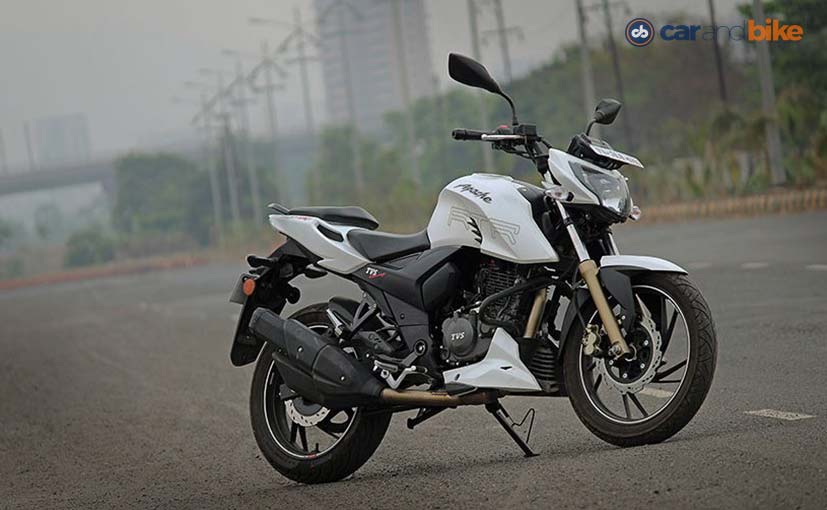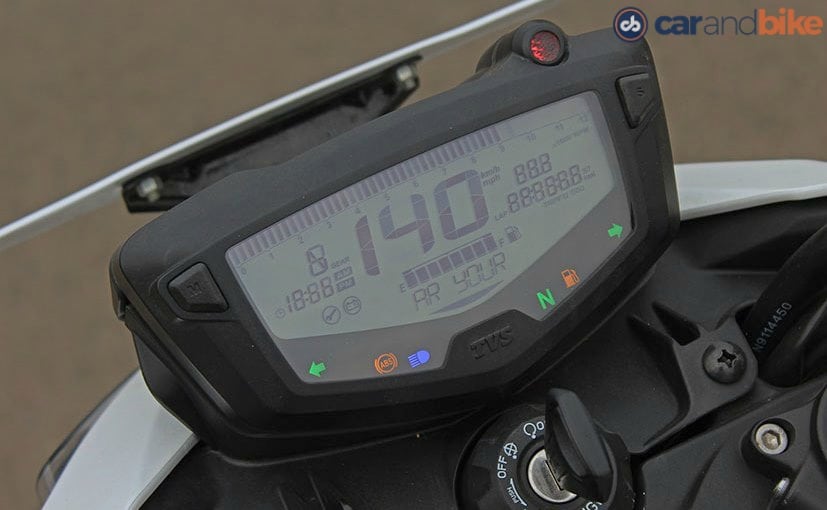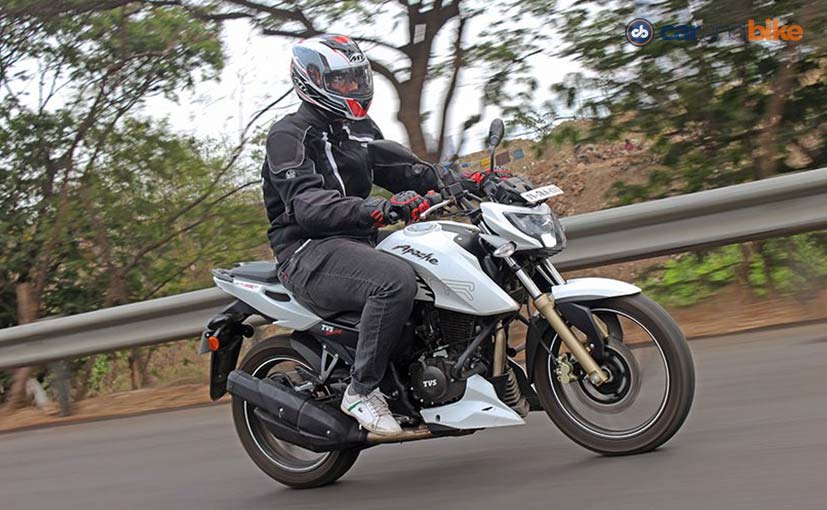Comparison Review: TVS Apache RTR 200 4V vs Bajaj Pulsar AS 200
Highlights
- The Bajaj Pulsar has dominated the 200cc segment for a while now
- The Apache RTR 200 impresses with its smooth revving motor
- Both companies have come a long way since their first performance bikes
It was a patient wait to see the TVS Apache RTR 200 4V finally come to production and also bring several novel upgrades to the popular motorcycle. However, the 200cc motorcycle segment is a hotly contested one and just being novel won't be enough. Now, Bajaj Auto knows this very well and that is why it has been offering a host of 200cc and above Pulsars right from the 220F, AS 200 as well as the flagship RS 200. That being said, it is the AS 200 that emerges as the offering that strikes a balance between modern tech as well as design, while also being more practical.
And that's what a certain set of customers are looking for, with their fair share of performance. This is where the new Apache RTR 200 4V carburetted version fits the bill right. Yes, the EFI system offers better throttle response and improved power, but the carburetted Apache is no less and goes easy on the pocket without taking away too much from the riding experience. Having lived with the Apache for a while now, it was time to see how does the flagship TVS stands up against Bajaj Auto's Pulsar AS 200 that promises to bring that 'Adventure Sport' quotient in your life. Guess who wins? Read on to find out.

The styling is understated on the TVS Apache RTR 200 4V
Design and Style
With the exception of the 'love it or hate it' design on the RS 200, Bajaj has churned out good looking motorcycles with the Pulsar series that appealed to the masses. In that respect, the new Pulsar AS 200 turns out to be my current favourite in the series with a highly appreciable design, tall frame and a dominating stance. It isn't surprising then, that you see so many AS 200s on the road compared to the RS. It's a design that appeals to all with the half fairing, small visor and projector headlamp thrown in for good measure.
The Bajaj Pulsar AS 200 boasts of a dominating presence
In contrast, the TVS Apache RTR 200 4V isn't as dominating to look at as the Pulsar. That said, it speaks understated, civilised and refined with the flow of its lines. The Apache remains true to the street-fighter styling borrowed from the Draken X-21 concept and it is a highly likeable motorcycle. The bulbous fuel tank is an attention grabber with the massive extensions and so are the split seats bringing lots of attention to it. The headlight cluster has a minimal effect to it and keeps things simple up front, which you grow to like.
While styling can be subjective, the TVS Apache stands out compared to the Bajaj Pulsar with a much higher attention to detail, not to forget better quality plastics as well. The Apache gets a matte paint finish, which the Hosur-based manufacturer has gotten really good at, which the AS 200 lacks. Lastly, the Pulsar sports an underbelly exhaust similar to the 200 NS, while the Apache gets a double-barrel side mounted exhaust and while it is the TVS that has a sweeter sound, the exhaust design could've been better.
The Apache's instrument console is loaded with information
Features and Ergonomics
There is no dearth on both motorcycles with respect to features, as both the Indian manufacturers manage to offer a lot for the price you pay. The Pulsar AS 200 sports an analog-digital instrument console that is a well-laid out unit with a host of information on display. It is also the more easily readable console, given the tall stance of the bike. In comparison, the Apache gets a feature packed all-digital console that has a plethora of information to share. Clearly, TVS takes the cake here with the additional modes like the gear indicator, lap timer, top speed recorder, shortest distance recorded and much more.
The AS 200's Instrument Console is easier to read
Nevertheless, the Pulsar AS 200 still manages to offer some exclusives like the projector headlamp that makes for a much better illumination compared to the Apache, while the illuminated switches receive are appreciated as well and are something that you do miss on the TVS offering. The switchgear quality though is better on the RTR 200. Both bikes get LED DRLs, but it is the one on the Apache that are permanently on.
Talking about ergonomics, both motorcycles aren't very aggressive and have the right seating position to offer. The foot pegs are rear seat on the both bikes too that complements the power, should you want to go aggressive. For taller riders, the Pulsar does serve as an advantage with its larger frame with the thighs perfectly aligning with the fuel tank indents, while the Apache is accommodating for riders of all sizes. The TVS also offers more comfortable cushioning, but the pillion will be a happier soul on the AS 200.

The TVS Apache 200 gets a refined motor, but with a beast of an exhaust note
Engine, Gearbox and Performance
It is quite clear that the Apache 200 is a notch above its predecessor. With the exception of power, there is little to complain about the offering from TVS. But, Bajaj is already offering a lot of that on the Pulsar AS 200 with 23.17bhp at 9500rpm and 18.3Nm of torque. That's almost 3 bhp more power over the TVS with a sixth ratio. And that's where the meat of the matter is. Certainly, the Pulsar is more powerful with a rev friendly engine and we appreciate the extra power and gear ratio. It gives the Bajaj an extra oomph at the top end of the power band, a higher redline and top speed, while you can hold on to the triple digit speeds longer.
The AS 200 offers better high speed stability
But at no cost is the TVS Apache 200 a slow performer with 20bhp of power at 8500rpm and 18.1Nm of torque at 8500rpm. The motorcycle starts with a bassier tone that you instantly like and get a slow and strong mid-range, which is felt between 60-90 kmph with enough power to push further. While doing triple digit speeds on either bikes, it is the Apache that feels the most composed with higher levels of refinement, which becomes even more apparent when you ride both bikes back-to-back. The lack of power though shows up in the top-end and you really wish there was more available at the flick of the throttle. Both bikes get seamless shifting gears, but it was on the Pulsar AS 200 that we found the neutral easily. The clutch feel is better on the Apache, but the Pulsar gets a lighter clutch in comparison.
The petal discs coupled with Pirelli tyres offer brilliant braking performance on the Apache
Ride, Handling and Braking
Handling has been the TVS Apache's forte and it pleases with the RTR 200 4V. The motorcycle's petite frame over the Pulsar makes it a sharp handler and has a quicker response to lane changes. Despite an older frame over rivals, the Apache is easier to chuck around corners with effortless ride ability within city limits. The AS 200 is equally quick if not better, but doesn't inspire the same confidence around corners as the TVS.
The Pulsar AS 200 gets as stiffer suspension setup
The Apache has been bestowed with a softer suspension setup and while it takes away from the fun only at the top end of the performance band, it does help attain a more comfortable rider quality. In contrast, the AS 200's suspension setup is stiffer, which makes it cumbersome to undulated roads. High speed stability is better on the Pulsar thanks to the half-fairing. TVS also offers the fabulous Pirelli tyres on the Apache that offer phenomenal grip and are worth the extra penny, as compared to the MRFs on the the Pulsar.
This results in much improved braking power on the Apache. In fact, the petal disc rotors do a great job in stopping the motorcycle with emergency stops being equally calm. TVS will also offer dual-channel ABS on the Apache further down the road, which is welcome move. The conventional discs on the Pulsar AS 200 offer excellent stopping power, but stability under hard braking isn't as composed as the TVS.
The Pulsar AS 200 gets a higher top speed, while TVS Apache RTR 200 is more refined
Verdict
Clearly, Bajaj wants to keep its existing customers happy while making it available for new ones as well. This is where the Pulsar AS 200 steps in treading the fine line between the old and new. Commanding a price of Rs. 94,049 (ex-showroom, Delhi), the AS 200 is the more value for money offering without a doubt. With just a few shortcomings, the AS 200 is an easy to live with motorcycle that also offers lots of style, features and a fail safe service back up from Bajaj.
But, if you want a more refined offering, without a doubt the TVS Apache RTR 200 4V is the motorcycle of your choice. With prices starting at Rs. 88,990 (ex-showroom, Delhi) for the carburetted version, the bike may seem cheaper than the AS 200, but optional the Pirelli tyres and dual-channel ABS will cost you more. Nevertheless, it looks good, has loads of features and grabs the right kind of attention with its design and exhaust note. It also makes for an excellent city performer without disappointing out on the highway if you choose to discover the outskirts of your city over the weekend.
A really close fight, the choice really boils down to the rider and for his style of riding. The Apache though makes for a compelling package bringing some novelty to the segment and that is hard to ignore, which makes it the winner of our comparison today.
Related Articles
Latest News
Research More on TVS Apache RTR 200 4V
Popular TVS Models
 TVS RoninEx-Showroom Price₹ 1.35 - 1.73 Lakh
TVS RoninEx-Showroom Price₹ 1.35 - 1.73 Lakh TVS Scooty Pep PlusEx-Showroom Price₹ 60,334 - 63,234
TVS Scooty Pep PlusEx-Showroom Price₹ 60,334 - 63,234 TVS XL 100Ex-Showroom Price₹ 43,041 - 54,160
TVS XL 100Ex-Showroom Price₹ 43,041 - 54,160 TVS Apache RR 310Ex-Showroom Price₹ 2.5 - 2.72 Lakh
TVS Apache RR 310Ex-Showroom Price₹ 2.5 - 2.72 Lakh TVS RadeonEx-Showroom Price₹ 59,925 - 74,966
TVS RadeonEx-Showroom Price₹ 59,925 - 74,966 TVS Apache RTR 160Ex-Showroom Price₹ 1.2 - 1.28 Lakh
TVS Apache RTR 160Ex-Showroom Price₹ 1.2 - 1.28 Lakh TVS Ntorq 125Ex-Showroom Price₹ 77,106 - 1.03 Lakh
TVS Ntorq 125Ex-Showroom Price₹ 77,106 - 1.03 Lakh TVS RaiderEx-Showroom Price₹ 84,869 - 1.02 Lakh
TVS RaiderEx-Showroom Price₹ 84,869 - 1.02 Lakh TVS JupiterEx-Showroom Price₹ 73,700 - 89,913
TVS JupiterEx-Showroom Price₹ 73,700 - 89,913 TVS SportEx-Showroom Price₹ 60,130 - 66,493
TVS SportEx-Showroom Price₹ 60,130 - 66,493 TVS Apache RTR 160 4VEx-Showroom Price₹ 1.25 - 1.4 Lakh
TVS Apache RTR 160 4VEx-Showroom Price₹ 1.25 - 1.4 Lakh TVS Star City PlusEx-Showroom Price₹ 71,205 - 73,955
TVS Star City PlusEx-Showroom Price₹ 71,205 - 73,955 TVS Apache RTR 180Ex-Showroom Price₹ 1.31 Lakh
TVS Apache RTR 180Ex-Showroom Price₹ 1.31 Lakh TVS Jupiter 125Ex-Showroom Price₹ 86,405 - 96,855
TVS Jupiter 125Ex-Showroom Price₹ 86,405 - 96,855 TVS Scooty Zest 110Ex-Showroom Price₹ 67,016 - 68,693
TVS Scooty Zest 110Ex-Showroom Price₹ 67,016 - 68,693 TVS iQubeEx-Showroom Price₹ 1.17 - 1.85 Lakh
TVS iQubeEx-Showroom Price₹ 1.17 - 1.85 Lakh TVS Apache RTR 200 4VEx-Showroom Price₹ 1.4 - 1.45 Lakh
TVS Apache RTR 200 4VEx-Showroom Price₹ 1.4 - 1.45 Lakh TVS Apache RTR 165 RPEx-Showroom Price₹ 1.45 Lakh
TVS Apache RTR 165 RPEx-Showroom Price₹ 1.45 Lakh TVS Apache RTR 310Ex-Showroom Price₹ 2.43 Lakh
TVS Apache RTR 310Ex-Showroom Price₹ 2.43 Lakh TVS Ronin 2025Ex-Showroom Price₹ 1.59 - 1.61 Lakh
TVS Ronin 2025Ex-Showroom Price₹ 1.59 - 1.61 Lakh TVS X ElectricEx-Showroom Price₹ 2.5 Lakh
TVS X ElectricEx-Showroom Price₹ 2.5 Lakh















